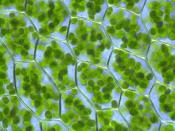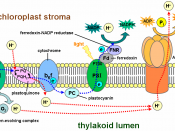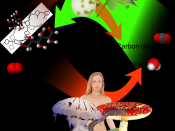Photosynthesis
Sunlight maintains and increases the orderliness of life by two methods: (1) directly, in the process of photosynthesis, which produces complex organic compounds, and (2) indirectly, in the respiration of those organic compounds, either by the organism itself or when it is consumed by another organism. (263) The two categories under this heading are Photoautotrophs, and Heterotrophs. Autotrophs make their own food, while Heterotrophs rely on food sources outside of themselves. Photoautotrophs include all green plants, all cyanobacteria, and a few bacteria capable of photosynthesis. Heterotrophs include all animals, all completely parasitic plants, all fungi, and nonphotosynthetic bacteria. These two categories apply to tissues, organs, and form of metabolism.
In photosynthesis, carbon dioxide is converted to carbohydrates; energy from sunlight to chemical energy. The "energy shuttle" produced in photosynthesis is adenosine triphosphate (ATP); it either forces a reaction to proceed, or enters into reactions that need energy.
ATP is converted to ADP and phosphate, and is used over and over between energy consumption and release. ADP can be phosphorylated to ATP by three methods. The first, photophosphorylation, only applies to autotrophs, since it involves light energy and a specific organelle, the chloroplast.
Lacking the necessary pigments and organelles, animals, fungi, and nonchlorophyllous plant tissues respire high energy
compounds they have consumed as food or, in the case of nonchlorophyllous plants, compounds are imported by phloem. High energy phosphate compounds are produced, and these force their phosphate onto ADP, creating ATP. This is substrate-level phosphorylation.
ADP is phosphorylated to ATP in the last stages of respiration by oxidative phosphorylation. This is a reaction involving oxygen, and it increases the positive charge on the atom, whereas reduction is the opposite; it reduces positive charge. This is known as a "redox reaction", since they occur simultaneously.
Photosynthesis combines...



Photosynthesis
nicely written. it helped me alot understanding about the energy intake and stuff. It would've helped if there were some pictures to look at or sumthing cause the ATP and other stuff is pretty confusing.(or maybe its just me)
3 out of 4 people found this comment useful.